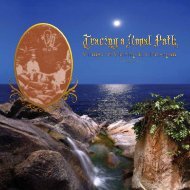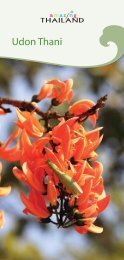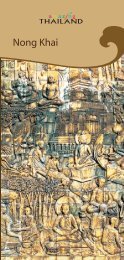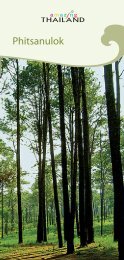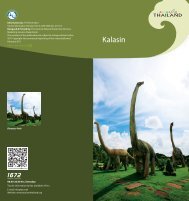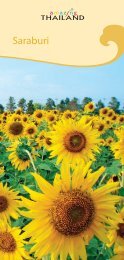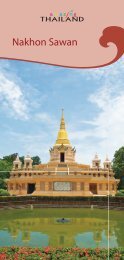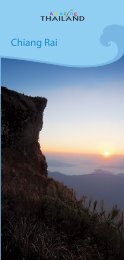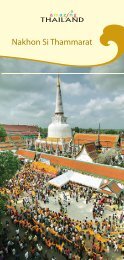Sukhothai - TourismThailand.org - Tourism Authority of Thailand
Sukhothai - TourismThailand.org - Tourism Authority of Thailand
Sukhothai - TourismThailand.org - Tourism Authority of Thailand
You also want an ePaper? Increase the reach of your titles
YUMPU automatically turns print PDFs into web optimized ePapers that Google loves.
34<br />
landmark includes the principal laterite circular stupa, which the bell-<br />
shaped part has already collapsed. A staircase in front leads from the<br />
wihan’s back porch to the bell-shaped body where a Buddha image<br />
is enshrined. In front <strong>of</strong> the principal chedi, there is a wihan with front<br />
and back porches. There are 5 staircases leading up to the wihan. The<br />
wihan’s columns and temple’s boundary wall are constructed from<br />
laterite.<br />
Wat Suan Kaeo Utthayan Noi or Wat Sa Kaeo �����������<br />
������������������������� Located 200 metres from Wat Chang Lom, the<br />
layout plan <strong>of</strong> Wat Suan Kaeo Utthayan Noi include buildings encircled<br />
by a demarcation wall, front gate, back gate, and main chedi in a<br />
lotus-bud shape. In addition, behind the wihan features a shrine in the<br />
form <strong>of</strong> a mondop with a pointed arched ro<strong>of</strong> enshrining an image <strong>of</strong><br />
the Buddha subduing Mara.<br />
Wat Nang Phaya�������������Adjacent to Wat Suan Kaeo Utthayan<br />
Yai, Wat Nang Phaya is famous for its delicate stucco reliefs on the<br />
remains <strong>of</strong> the northwestern wall <strong>of</strong> the 7-roomed wihan or image<br />
hall. The principal circular stupa is supported by a circumambulation<br />
base. The relic chamber <strong>of</strong> the chedi housing its core decorated by<br />
stucco relief is accessible by a set <strong>of</strong> stairs from the front. The wihan<br />
building is made <strong>of</strong> laterite blocks with front and back porches. The<br />
wall was made into slit windows to let in light. The exterior face <strong>of</strong> the<br />
wihan’s southern walls are decorated with highly elaborated stucco<br />
<strong>of</strong> creatures - half man half monkey – running. However, part <strong>of</strong> it has<br />
already been destroyed. Other elaborated stucco includes plants and<br />
angels in adoration bearing the art style <strong>of</strong> the early Ayutthaya period.<br />
Wat Chom Chuen ������������<br />
Wat Chom Chuen, which is 400 metres<br />
east <strong>of</strong> Wat Phra Si Rattana Mahathat, is situated by the Yom River.<br />
The prominent landmark includes the principal circular stupa made<br />
<strong>of</strong> laterite, where a laterite 6-roomed wihan with a front porch is in<br />
front <strong>of</strong> it. The back <strong>of</strong> the wihan is connected to a mondop, which<br />
resembles a dimmed room. The mondop has laterite gable roo�ng.<br />
The front on both sides <strong>of</strong> mondop features 2 niches. At the back<br />
also features a niche, where a seated Buddha image protected by<br />
the seven-headed naga was formerly enshrined. However, it has now<br />
disappeared. In addition, this mondop is decorated with beautiful<br />
stucco on the back pediment.<br />
From the archaeological excavations conducted at the depth <strong>of</strong> 7 – 8<br />
metres in front <strong>of</strong> the wihan, 15 skeletons were found. These human




